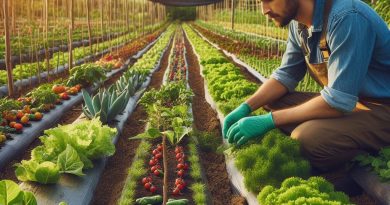Crop Productivity: Winning Over Weeds
Last Updated on February 27, 2024
Introduction
Crop productivity is crucial in farming as it directly affects food production and economic growth.
Weeds pose a significant threat to crop yield, reducing productivity and profitability.
This blog post aims to explore effective strategies to control weeds and enhance crop productivity.
Weeds not only compete with crops for essential resources like sunlight, water, and nutrients but also harbor pests and diseases.
As a result, they can cause a substantial reduction in crop yield, jeopardizing food security and income for farmers.
In this blog post, we will discuss various techniques and methods to combat weeds and improve crop productivity.
We will explore both conventional and sustainable approaches, providing insights into their pros and cons, as well as practical implementation.
Key sections to be covered include:
- Understanding the Impact of Weeds: In this section, we will delve deeper into the negative impact of weeds on crop yield, identifying specific challenges faced by farmers.
- Weed Control Methods: Here, we will explore a range of weed control strategies, including mechanical, chemical, and biological approaches. We will highlight their effectiveness and potential risks.
- Integrated Weed Management: This section will emphasize the importance of an integrated approach, combining multiple weed control strategies to achieve maximum results while minimizing environmental impacts.
- Sustainable Weed Management: Addressing the growing demand for sustainable agriculture, we will discuss eco-friendly weed management practices that promote long-term crop productivity without harming ecosystems.
In essence, enhancing crop productivity requires effective weed management practices.
By tackling weed infestation, farmers can significantly increase crop yield, ensuring food security and economic stability.
Stay tuned for upcoming sections, where we will delve deeper into this vital topic and provide actionable insights for farmers.
Understanding Weeds
Weeds are plants that grow where they are not desired and have aggressive characteristics.
They possess characteristics that make them resilient and adaptable, such as rapid growth rates, prolific seed production, and the ability to thrive in diverse environments.
Weeds can spread aggressively, utilizing various reproductive strategies like wind-dispersed seeds or underground rhizomes.
They often exhibit tolerance to adverse conditions and can outcompete desired vegetation, impacting agricultural productivity, biodiversity, and ecosystem stability.
Control measures typically involve cultural, mechanical, or chemical methods to manage their growth and spread.
Reasons why weeds pose a threat to crops include competition for resources, allelopathy, and disease transmission.
Weeds compete with crops for essential resources such as water, nutrients, and sunlight, reducing crop yields.
They can also harbor pests and diseases, increasing the likelihood of crop damage.
Weeds interfere with agricultural operations, making planting, cultivation, and harvesting more difficult and costly.
Some weeds release allelopathic chemicals that inhibit the growth of nearby crops.
Additionally, weeds can reduce crop quality by contaminating harvested produce.
Their rapid growth and ability to adapt to various environments make them challenging to control, leading to significant economic losses for farmers worldwide.
Overall, weeds pose a multifaceted threat to crop productivity and agricultural sustainability.
Not controlling weeds effectively can lead to decreased crop yields, reduced quality, and increased production costs.
Failure to control weeds effectively can lead to numerous consequences.
Firstly, weeds compete with crops for essential resources like water, sunlight, and nutrients, reducing yields and quality.
Additionally, weeds can harbor pests and diseases, exacerbating agricultural problems.
Their rapid spread can outcompete desired plants, leading to soil erosion and loss of biodiversity.
Moreover, neglected weed management can escalate into costly and labor-intensive control measures, impacting farmers’ profitability and sustainability.
Environmental degradation, decreased food security, and economic losses are thus prevalent outcomes of ineffective weed control strategies.
Techniques for Weed Control
Manual Weed Control Methods (Hand-pulling, Hoeing)
- Manual weed control involves physically removing the weeds by hand-pulling or using a hoe.
- Benefits include low cost, no chemical usage, and minimal impact on the environment.
- Drawbacks include labor-intensive, time-consuming, and may not be effective for large-scale farming.
Mechanical Weed Control Methods (Tillage, Mowing)
- Mechanical weed control involves using machinery to till the soil or mow the weeds.
- Tillage disrupts the weed’s root system and buries the seeds, preventing their germination.
- Mowing cuts the weeds at the base, reducing their competition with crops for nutrients and sunlight.
- Benefits include efficiency, cost-effectiveness, and suitability for large-scale farming.
- Drawbacks include soil erosion risk, potential damage to crops, and fuel consumption.
Chemical Weed Control Methods (Herbicides)
- Chemical weed control involves the use of herbicides to kill or inhibit the growth of weeds.
- Herbicides can be selective (target specific weeds) or non-selective (kill all vegetation).
- Benefits include high effectiveness, time-saving, and can cover large farming areas.
- Drawbacks include potential harm to non-target plants, water pollution, and health risks.
Biological Weed Control Methods (Introducing Natural Enemies)
- Biological weed control involves introducing natural enemies, like insects or animals, to prey on weeds.
- These natural enemies can control weed growth by feeding on them or disrupting their reproductive cycle.
- Benefits include long-term sustainability, minimal impact on the environment, and reduced chemical usage.
- Drawbacks include limited control over the natural enemies’ behavior and potential disruption of ecological balance.
Importance of an Integrated Approach for Effective Weed Control
While each weed control technique has its advantages and drawbacks, using an integrated approach is crucial for effective weed control.
An integrated approach combines multiple methods, such as a combination of manual, mechanical, chemical, and biological techniques, to target weeds more comprehensively.
By diversifying the control methods, farmers can minimize reliance on a single method and reduce the risk of developing weed resistance to certain techniques.
Moreover, an integrated approach considers the specific needs and capabilities of the farm, the type of crops grown, and the severity of the weed problem.
It allows farmers to maximize the benefits of each technique while minimizing their drawbacks, leading to sustainable crop productivity and weed management.
Read: Sustainable Water Use in Farms
Best Practices for Weed Management
Importance of Crop Rotation and Diversification
- Crop rotation helps disrupt weed life cycles and reduces the buildup of weed populations.
- Diversifying crops reduces the dominance of specific weed species in a field.
- Varying planting dates and crop types can further minimize weed competition.
Significance of Timing in Weed Control Measures
- Early weed control is crucial to prevent weed establishment and competition with the crops.
- Understanding the life cycles of various weed species aids in selecting appropriate control methods.
- Timing herbicide applications during the most vulnerable growth stages of weeds maximizes effectiveness.
Recommendations for Proper Irrigation and Fertilization
- Providing adequate water and nutrients to crops enhances their competitiveness against weeds.
- Applying water evenly and using proper irrigation techniques reduces weed germination and growth.
- Precision fertilization ensures optimal crop growth without promoting excessive weed growth.
The Role of Mulching and Weed Barriers in Weed Suppression
- Mulching inhibits weed emergence by blocking sunlight and reducing weed seed germination.
- Weed barriers, such as landscape fabric or plastic sheets, prevent weed penetration in crop rows.
- Both mulching and weed barriers also retain soil moisture, benefiting crop growth.
Regular Monitoring and Scouting of Fields
- Frequent field inspections allow early detection of weed infestations and prevent their spread.
- Identifying and addressing weed problems promptly minimize crop yield losses.
- Scouting fields also helps determine the effectiveness of weed management practices employed.
Read: Pumpkin Picking: Perfect Timing Tips

Emerging Technologies and Innovations
Recent Advancements in Technology for Weed Detection and Control
Technology has played a crucial role in revolutionizing weed detection and control in modern agriculture. With the development of sophisticated sensors and imaging techniques, farmers can now easily identify weed-infested areas of their fields with high precision.
This allows for targeted and efficient weed management strategies.
One such advancement is the use of remote sensing technologies, including aerial imagery and satellite data. These tools provide a bird’s-eye view of the entire field, enabling farmers to identify weed hotspots and take timely action to address them.
Additionally, drones equipped with advanced cameras and sensors can capture high-resolution images, aiding in weed detection.
Another breakthrough is the development of automated weed detection systems. These cutting-edge technologies utilize machine learning algorithms to recognize and classify different weed species based on their visual characteristics. This not only saves valuable time but also reduces the reliance on manual labor.
Benefits of Precision Agriculture in Minimizing Weed Pressure
Precision agriculture, also known as site-specific farming, has emerged as a powerful approach in minimizing weed pressure. By precisely targeting inputs such as water, fertilizers, and herbicides, farmers can reduce wastage while maximizing crop yield.
This not only improves overall productivity but also minimizes the opportunity for weeds to thrive.
With the help of GPS technology, farmers can create accurate field maps and delineate areas where weed density is high.
This information is then used to develop customized weed management strategies, ensuring that herbicides are applied only where needed.
As a result, unnecessary chemical use is minimized, enhancing environmental sustainability.
Moreover, precision agriculture enables farmers to adopt alternative weed control methods, like thermal weed treatment and polarization.
These practices offer targeted weed suppression without the need for herbicides, reducing the risk of developing herbicide-resistant weed populations.
Introduction of Robotic Weeders and Their Potential Impact on Crop Productivity
Robotics is paving the way for a new era of weed control, promising significant improvements in crop productivity. Robotic weeders are autonomous machines equipped with advanced imaging systems and mechanical tools to precisely identify and remove weeds.
These robots work tirelessly, tirelessly patrolling the fields and detecting weeds in real-time.
Once a weed is identified, the robotic arm equipped with specialized tools can delicately remove the intruder without causing any damage to the crop.
This level of precision ensures minimal disruption to the surrounding plants, leading to improved yield and reduced manual labor.
The potential impact of robotic weeders extends beyond weed removal. By leveraging machine learning algorithms, these robots can continuously learn and adapt to different weed species and growth patterns.
This adaptive capability allows them to optimize weed control strategies and minimize the risk of weed regrowth.
Development of Genetically Modified Crops for Enhanced Weed Resistance
Scientists and researchers have been actively working on developing genetically modified (GM) crops with enhanced weed resistance.
Genetic modification techniques enable the introduction of genes that confer traits such as herbicide tolerance or altered growth patterns, making crops more resistant to weed competition.
One prominent example is the development of herbicide-tolerant crops. These crops are engineered to withstand specific herbicides that can effectively control weeds while causing minimal harm to the cultivated plants.
By adopting these GM crops, farmers can simplify weed management practices and achieve better crop productivity.
Furthermore, the use of genetically modified crops reduces the reliance on conventional herbicides, promoting more sustainable weed control strategies.
It also offers an additional tool in integrated weed management, complementing other approaches like crop rotation and mechanical weed control.
Overall, emerging technologies and innovations in weed detection and control are transforming the way we manage weeds in crop production.
From remote sensing and precision agriculture to robotic weeders and genetically modified crops, these advancements offer more efficient, targeted, and sustainable solutions.
As we continue to harness the power of technology, farmers can look forward to winning over weeds and improving crop productivity in a more environmentally friendly manner.
Read: Grape Harvesting for Winemaking
Sustainable Weed Management Strategies
The concept of sustainable weed management
Implementing sustainable weed management practices is crucial for ensuring long-term crop productivity and environmental sustainability.
By adopting these strategies, farmers can effectively control weeds while minimizing the use of synthetic chemicals.
Sustainable weed management focuses on achieving a balance between weed control and preserving the natural ecosystem.
This approach recognizes that weeds are a natural part of agricultural systems and aims to manage them rather than eradicate them completely.
The importance of promoting beneficial insects and pollinators for natural weed control
Promoting beneficial insects and pollinators is one of the key components of sustainable weed management.
These insects play a vital role in ecological balance and can provide natural weed control services.
Ladybugs, for example, are voracious predators that feed on aphids and other weed pests.
By attracting and retaining ladybugs within the crop fields, farmers can reduce the impact of weeds on crop plants.
Similarly, parasitic wasps can lay eggs on weed seeds, effectively destroying them before they can germinate.
Significance of organic farming practices in weed suppression.
In addition to natural controls, organic farming practices also contribute to weed suppression.
Crop rotation, for instance, involves alternating crops to disrupt weed life cycles and reduce weed pressure.
This practice not only suppresses weeds but also enhances soil health, nutrient cycling, and disease control.
Cover cropping is another effective organic weed management strategy. Planting cover crops, such as clover or rye, provides living ground cover that competes with weeds for resources like sunlight, water, and nutrients.
Mulching, which involves covering the soil surface with organic materials like straw or wood chips, also helps suppress weed growth by preventing weed seed germination and reducing light availability.
The use of environmentally-friendly herbicides as an alternative to conventional chemicals
To further enhance sustainable weed management, environmentally-friendly herbicides can be utilized. These alternatives to conventional chemicals pose fewer risks to humans, animals, and the environment.
Some herbicides are derived from plant extracts, such as vinegar or citric acid, which can effectively kill weeds without persisting in the environment or contaminating water sources.
Biological herbicides, derived from naturally occurring organisms like bacteria or fungi, can target specific weed species while leaving beneficial plants unharmed.
These herbicides offer a targeted and ecologically sound approach to weed control.
By adopting sustainable weed management practices, farmers can minimize the negative impact of weeds on crop productivity while ensuring the long-term health of ecosystems.
These holistic approaches not only provide effective weed control but also contribute to biodiversity conservation, soil conservation, and the protection of human health.
Embracing sustainable weed management is a win-win strategy for both farmers and the environment.
Read: Hop Harvesting for Craft Brewing
Conclusion
Effective weed control plays a crucial role in enhancing crop productivity. Weeds compete with crops for essential resources such as sunlight, water, and nutrients, resulting in reduced yields.
By implementing integrated weed management strategies, farmers can maintain the health and productivity of their crops in the long term.
Integrated weed management involves using a combination of cultural, mechanical, biological, and chemical control methods to effectively combat weeds.
By diversifying weed control approaches, farmers can minimize the development of herbicide resistance and reduce the reliance on chemical treatments.
It is vital for farmers to realize that weed management is an ongoing process that requires constant monitoring and adaptations.
Regular field scouting and early intervention are essential to prevent weeds from becoming established and causing significant damage.
Additionally, implementing crop rotation, proper tillage practices, and cover cropping can help suppress weed growth and improve soil health.
We encourage farmers to share their own experiences and knowledge regarding weed management. By exchanging information, we can collectively develop innovative strategies and solutions to tackle the challenges posed by weeds.
Furthermore, farmers are encouraged to consult with agricultural experts, attend workshops, and participate in online forums to stay updated on the latest research and techniques in weed control.
Let us work together to win the battle against weeds and maximize crop productivity. Share your experiences, ask questions, and be part of the conversation.
Together, we can achieve sustainable and successful weed management practices that benefit both farmers and the environment.


